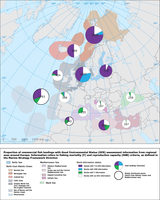
This figure shows the proportion of commercial fish landings per regional sea with Good Environmental Status (GES) assessment information, as defined in the Marine Strategy Framework Directive. GES information is broken down by level of exploitation (F) and reproductive capacity (SSB) criteria.

Stations showing a statistically significant decrease (green), increase (red) or no trend (grey) of winter oxidised nitrogen concentrations within the period 1985 to 2012. Selected stations must have data, at least, in the period 2007-2012 and must have at least five years data in all.

The maps show areas where critical loads for eutrophication of freshwater and terrestrial habitats are exceeded (CSI 005) by nitrogen depositions caused by emissions between 1980 (top left) and 2030 (bottom right)

The maps show the average accumulated exceedance of critical loads for acidification in 1980 (top left), 1990 (top right), 2000 (middle left), 2010 (middle right), 2020 under the revised Gothenburg Protocol scenario emission reduction agreements (bottom left) and 2030 assuming maximum technically feasible reduction (bottom right).

The figure shows modelled global mean sea level rise over the 21st century relative to 1986-2005, derived from a combination of the CMIP5 ensemble with process-based models, for RCP2.6 and RCP8.5.

The graphs shows the results from a study that estimates regionally averaged changes in surface ozone due to past or future changes in anthropogenic precursor emissions based on 14 global chemistry transport models.

The left panel of the figure shows the average middle class consumption per capita for selected world regions/countries. Middle class is defined as people living in households earning and spending between 10 and 100 per person per day (2005 US dollars, in purchasing power parity).

The figure compares average surface temperature for the baseline period 1986-2005 to projections for 2081-2100, as two world maps.

The Human Development Index is calculated using three components: education,
life expectancy at birth and wealth. It is expressed as a value between 0 and 1, from
less to most developed countries.
The Ecological Footprint measures how much land and water area a population
requires to produce the resources it consumes and to absorb its waste. The world
biocapacity is the global productive area available on Earth (it decreases as
population grows).